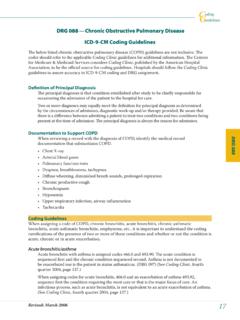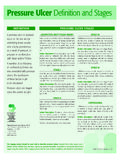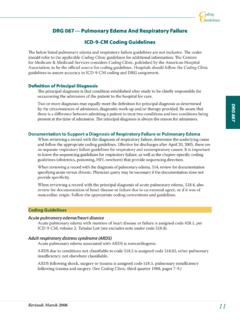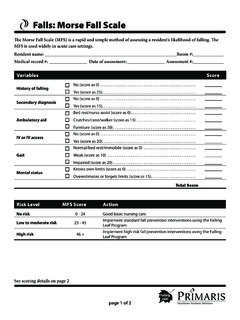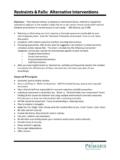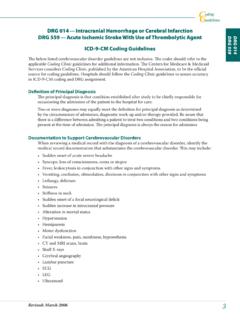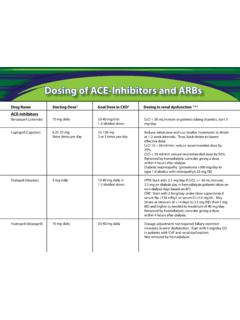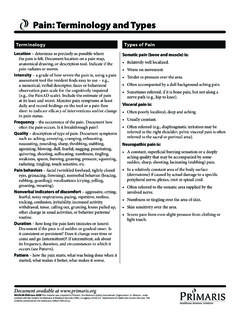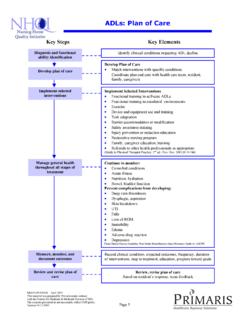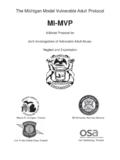Transcription of ACTIVITIES OF DAILY LIVING (ADL) DECLINE - …
1 ACTIVITIES OF DAILY LIVING (ADL) DECLINE The Guide to physical Therapist Practice defines disability broadly as the inability or restricted ability to perform actions, tasks, and ACTIVITIES related to required roles in the individual s sociocultural context and physical environment. Thus the concept of disability includes deficits in the performance of ADLs ( ACTIVITIES of DAILY LIVING ) (Guide to physical Therapist Practice, 2001). There are various definitions of ADL disability, but regardless of definition, the majority of older adults LIVING in nursing homes require some assistance with ACTIVITIES of DAILY LIVING (Aller & Coeling, 1995).
2 Approximately 91% require assistance with bathing, followed by 78% in and 40% in eating. Almost two-thirds require assistance in transferring from bed to chair, and about the same percentage have walking difficulties (Resnick, 1999). For long stay residents in nursing homes, functional DECLINE is often viewed as an inevitable consequence of chronic disease, cognitive disability, and extreme age. Too frequently the forces driving functional DECLINE are viewed as immutable.
3 The central issue is one of attention to the possibility of breaking this cycle of DECLINE (Morris, 1999). The evidence is overwhelming that health care providers can influence the functional outcomes of nursing home residents. Health professionals will play an even greater role in treating function and disability as our aging population expands. Kunkel and Applebaum (1992) project that by the year 2020, from to million older people will have moderate to severe disability.
4 These ADL-related materials are intended as a resource for nursing home staff to help residents improve their abilities to manage self-care ACTIVITIES ; that is, ..the ability to perform ACTIVITIES of DAILY LIVING (ADL) such as bed mobility, transfers, dressing, grooming, bathing, eating, and toileting (Guide to physical Therapist Practice, 2001). Although ADLs encompass all these self-care ACTIVITIES , the materials provided in this packet focus primarily on the four late-loss ADLs of bed mobility, transfers, toilet-use, and eating.
5 These four ACTIVITIES are standard ADL items scored on all resident Minimum Data Set (MDS) assessments, and are key components of the ADL index for Resource Utilization Group (RUG) categories. The Centers for Medicare & Medicaid Services have also identified ADL DECLINE for bed mobility, transfers, toilet-use, and eating, as one of the quality measures for nursing homes to publicly report beginning in October 2002. Models of Functioning and Disability A number of disablement models have emerged during the past three decades (ICIDH, Nagi, ICF).
6 All of the disablement models attempt to better delineate the ADL DECLINE 1 interrelationships among disease, impairments, functional limitations, disabilities, handicaps, and the effects of the interactions of the person with the environment (Brandt et al., 1997) though the effects themselves may be defined differently from model-to-model (Guide to physical Therapist Practice, 2001). International Classification of Functioning, Disability and Health (ICF) offers a useful model of functioning and disability.
7 ICF represents a revision of the International Classification of Impairments, Disability and Handicaps (ICIDH), which was first published by the World Health Organization (WHO) for trial purposes in 1980. The ICF model differs significantly from the 1980 version of the ICIDH in the depiction of the interrelations between functioning and disability (WHO, 2001). The ICF model provides a multi-perspective approach to the classification of functioning and disability as an interactive and evolutionary process.
8 A person s functioning and disability is conceived as a dynamic interaction between health conditions (disease, disorders, injuries, traumas, etc.) and contextual factors (environmental and personal). The figure below may help with visualizing the current understanding of interaction of various components of the functioning and disability model. (See FIGURE on Page 6) Interaction between Health Components, Function, and Disability Many signs and symptoms, and many of the conditions that affect a person s ability to function, are not associated with a single active pathology/pathophysiology, nor are they always found to have an impact exclusively on a single system of origin (Guide to physical Therapist Practice, 2001).
9 Thus it is to distinguish health conditions from the functional disability that they may cause (Parmelee, 1995). The ICF model of functioning and disability underscores the importance of interactions between all components of health (physiological, psychological, anatomical, activity- or participation-related, personal, and/or environmental). Understanding the influence of health components in totality, rather than in isolation, is particularly important when evaluating function in the geriatric population.
10 The approach to disability in the older person must consider both the person and his/her environment as well as the underlying diseases. Geriatric disability is often multi-causal, and a variety of factors can increase or decrease the likelihood of (Hoenig, 1997). Medical stability, cognitive function, patient motivation, and duration of disability may all modify the use of rehabilitation interventions and/or alter the goals of rehabilitation (Kemp, 1990). For some conditions it may be necessary to resolve acute medical problems before a meaningful assessment of rehabilitation potential can be made ( , delirium, pneumonia) or before starting rehabilitation ( , hemodynamic stabilization before rehabilitation) (Hoenig, 1997).
